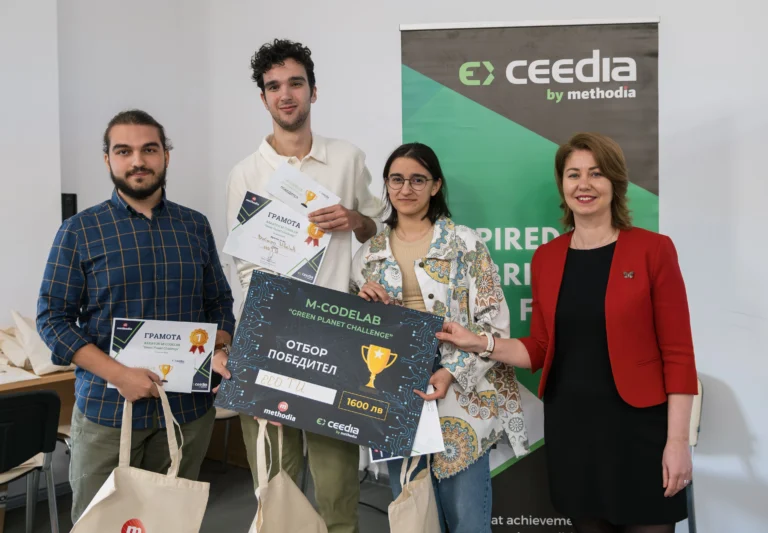What amount of carbon emissions will we save if we use an electric car? And if we plant a forest? How do we calculate the cost of saved carbon emissions and convert them into virtual money?
The tech hackathon ‘M-CODELAB’ was held once again this year, with a continued focus on addressing global climate change challenges. This year’s event featured the “Green Planet Challenge” as its central theme. The challenge encourages young innovators to develop a software tool that acts as a consultant for various organizations, assessing their environmental impact and suggesting measures to mitigate adverse effects, including participation in exemplary environmental compensation projects.
‘Carbon offset projects are an effective method that helps reduce carbon emissions and contributes to environmental sustainability. They allow individuals and organizations to partially or completely offset the carbon emissions from their activities.’ explains Tsvety Kyoseva, CEO of Methodia.
‘The initiative transcends a mere competition with prizes; it serves as a platform for idea exchange,’ Kyoseva stated during the award ceremony. ‘All participants showcased exceptionally high-level developments, challenging the jury with their selections. The teams did more than just work on projects – they crafted opportunities for a better world and collectively transformed their ideas into tangible solutions that will make an impact. Let today be recognized as a milestone of success and the genesis of future innovations. We celebrate each advancement, every innovative method, and each idea shared.’
During the educational hackathon from March 4 to April 5, 2024, the young talents competed with their eco-projects related to the amount of generated and removed carbon emissions. Out of the seven participating teams, six have fully realized their ideas. Throughout the four weeks, as they worked nearly around the clock, they received continuous support from mentors. The teams had to find a solution to an environmental problem and demonstrate possibilities for measuring carbon emissions in a real environment. To implement their projects, it was first necessary to research their chosen business area through additional online materials, then to architect a project solution including the selection of technologies for implementation, components, and how communication between them would be facilitated. The final weeks were dedicated to development, testing, and refining details.
One of the conditions of the contest was for each team to make a demo recording of their project, not to use pre-written code in their developments, to demonstrate working functionality, and to choose one of the six possible ways of carbon compensation – through tree planting, using electric cars, wind installations, photovoltaics, reducing the use of plastic and paper materials, and through the equivalent reduction of generated carbon emissions and financing initiatives to purchase carbon quotas.
Virtual exchange for trading M-Coins
Participants calculated ‘M-Coins’ – a tradable instrument that can be earned when one ton of carbon is removed from the atmosphere or avoided, according to the amount of removed carbon emissions. This currency resembles the well-known real-world carbon credit.
‘When an organization takes the initiative, such as planting a large number of trees, they absorb carbon dioxide, which is considered compensation for the carbon dioxide by that organization. The challenge for the participants was to calculate the amounts of compensated carbon dioxide according to these six scenarios – for example, what would be the difference if an organization replaced conventional electric energy use with a photovoltaic system, taking into account specific parameters, calculations, and emission factors – such are available for electric energy, fuels, solid or liquid, different tree species, etc.,’ explains Radoslav Doychinov, Business Consultant at Methodia and mentor in the competition. Another case the participants worked on, for example, was what would be the difference if a logistics company with a large fleet decided to replace its diesel vehicles, which have a high emission factor, with electric cars.

The grand prize was awarded to four students from Team “ECO TU” at Technical University-Varna, who received a monetary award for their innovative development – a ‘green’ website, not only providing information about various ecological activities but also offering the opportunity to trade with virtual monetary assets obtained from saving carbon emissions. What impressed the jury was the section representing a virtual exchange for trading M-Coins. The many parameters used by the youths in their calculations, such as over 30 tree species with their specific emission factor, including the age of the trees (in the scenario with afforestation), were not to be underestimated.
Equally impressive were the projects of other students who took second and third place, who received gaming headphones (for second place) and gaming mice (for third place).
‘DFantastic4’, again from the Technical University of Varna, won second place for their application covering all six stipulated scenarios for carbon compensation. The participants were distinguished for their complex calculations, and comparisons between different types of fuel, and different aircraft, including the use of a radiation impact index in calculating the amount of carbon dioxide. The third prize was awarded to the 11th graders from ‘Mlem Shot’, who developed scenarios for carbon offsetting through photovoltaics and wind turbines, performing the most complex calculations. They integrated their application with the NASA Power API, utilizing various parameters such as solar irradiance angle, atmospheric pressure, air temperature, wind speed, air density, and more.
Due to their innovative approach, the students from PlanSec (also from TU-Varna) were awarded a special prize. They developed an eco-app with two notable features for users: one feature rewards those who have saved more carbon emissions with event tickets or discounts at retail outlets, and the other allows users to chat directly with the creators about climate issues.
The VIRGAS’ project, from students at the Technical University of Sofia, focused on a website featuring intuitive sections for carbon offset calculations. Meanwhile, Ivelin from TU-Sofia developed an application that calculates the carbon emissions saved through reforestation efforts.
Future Opportunities in Eco-Innovation
‘The projects definitely have the potential to become a reality if they are supported by the business community. From the perspectives of functionality and technical development, each project could become viable if further developed and refined, as they all incorporate accurate computational approaches and emission factors,’ commented Doychinov.
Inspired by the innovative ideas and enthusiasm of the young participants, and with a belief that together, teams, mentors, and partners can effect substantial changes, Methodia is inviting all participants in the eco-competition to engage in a practical project: the development of a carbon emissions calculator, which is already certified by an accredited institution.





